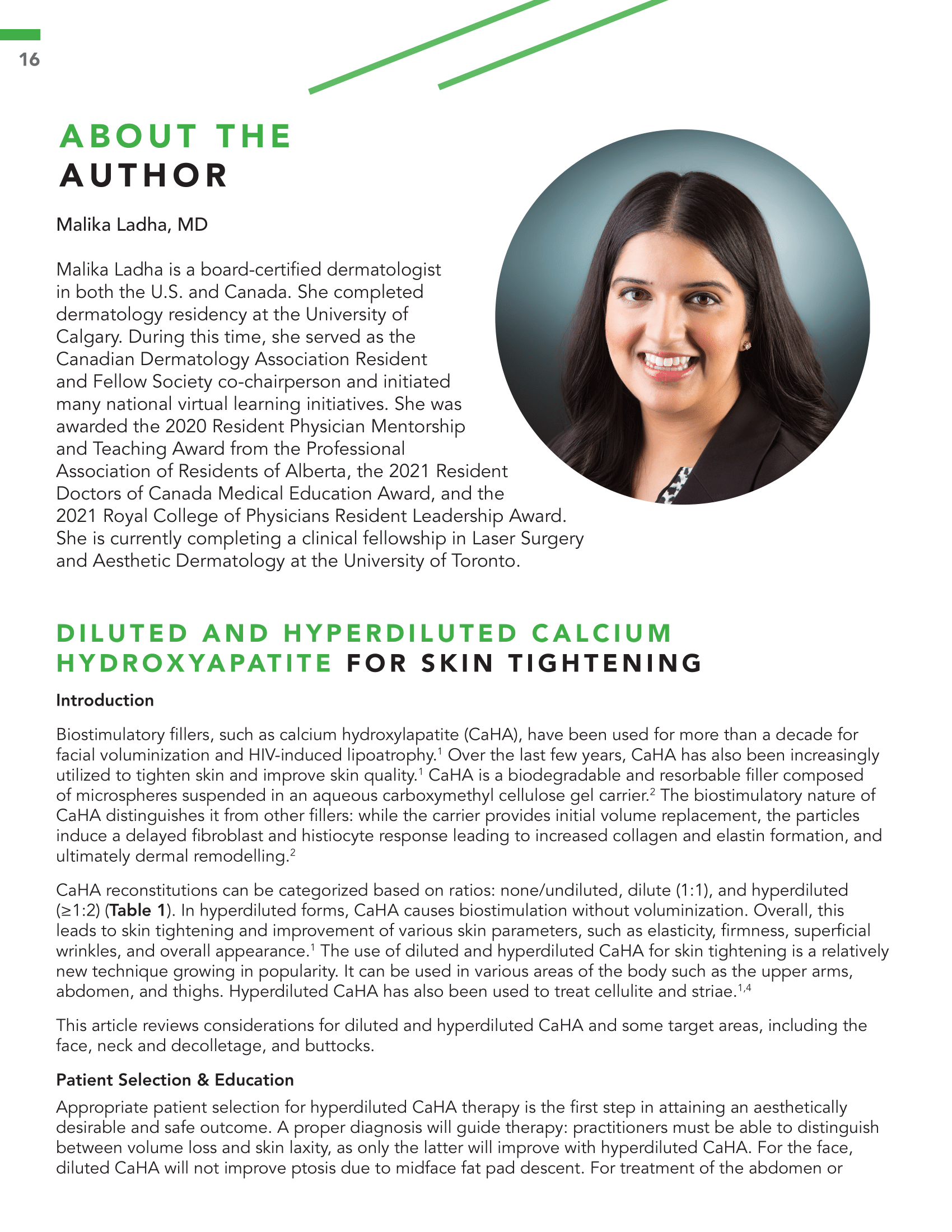Diluted and Hyperdiluted Calcium Hydroxyapatite For Skin Tightening
Abstract
Biostimulatory fillers, such as calcium hydroxylapatite (CaHA), have been used for more than a decade for facial voluminization and HIV-induced lipoatrophy. Over the last few years, CaHA has also been increasingly utilized to tighten skin and improve skin quality. CaHA is a biodegradable and resorbable filler composed of microspheres suspended in an aqueous carboxymethyl cellulose gel carrier. The biostimulatory nature of CaHA distinguishes it from other fillers: while the carrier provides initial volume replacement, the particles induce a delayed fibroblast and histiocyte response leading to increased collagen and elastin formation, and ultimately dermal remodelling.
CaHA reconstitutions can be categorized based on ratios: none/undiluted, dilute (1:1), and hyperdiluted (≥1:2). In hyperdiluted forms, CaHA causes biostimulation without voluminization. Overall, this leads to skin tightening and improvement of various skin parameters, such as elasticity, firmness, superficial wrinkles, and overall appearance. The use of diluted and hyperdiluted CaHA for skin tightening is a relatively new technique growing in popularity. It can be used in various areas of the body such as the upper arms, abdomen, and thighs. Hyperdiluted CaHA has also been used to treat cellulite and striae.
References
Goldie, Kate et al. “Global Consensus Guidelines for the Injection of Diluted and Hyperdiluted Calcium Hydroxylapatite for Skin Tightening.” Dermatologic surgery: official publication for American Society for Dermatologic Surgery [et al.] vol. 44 Suppl 1 (2018): S32-S41.
Berlin A, Cohen JL, Goldberg DJ. Calcium hydroxylapatite for facial rejuvenation. Semin Cutan Med Surg 2006;25:132–7.
De Almeida, Ada Trindade et al. “Consensus Recommendations for the Use of Hyperdiluted Calcium Hydroxyapatite (Radiesse) as a Face and Body Biostimulatory Agent.” Plastic and reconstructive surgery. Global open vol. 7,3 e2160. 14 Mar. 2019.
Yutskovskaya YA, Kogan EA. Improved neocollagenesis and skin mechanical properties after injection of diluted calcium hy- droxylapatite in the neck and décolletage: a pilot study. J Drugs Dermatol. 2017;16:68–74.
Yutskovskaya Y, Kogan E, Leshunov E. A randomized, split-face, histomorphologic study comparing a volumetric calcium hy-droxylapatite and a hyaluronic acid-based dermal filler. J Drugs Dermatol. 2014;13:47–52.
Lorenc, Z Paul et al. “Skin Tightening With Hyperdilute CaHA: Dilution Practices and Practical Guidance for Clinical Practice.” Aesthetic surgery journal vol. 42,1 (2022): NP29- NP37. doi:10.1093/asj/sjab269
Van Loghem JA, Humzah D, Kerscher M. Cannula versus sharp needle for placement of soft tissue fillers: an observational cadaver study. Aesthet Surg J. 2017;38:73–88.
Chao YY, Chiu HH, Howell DJ. A novel injection technique for horizontal neck lines correction using calcium hydroxylapatite. Dermatol Surg. 2011;37:1542–1545.
Sasaki G, Tevez A. Microfocused ultrasound for nonablative skin and subdermal tightening to the periorbitum and body sites: preliminary report on eighty-two patients. J Cosmet Dermatol Sci Appl 2012;2: 109–16.
Tzikas TL. A 52-month summary of results using calcium hydroxylapatite for facial soft tissue augmentation. Dermatol Surg 2008;34(Suppl 1):S9–15.
Smith S, Busso M, McClaren M, Bass LS. A randomized, bilateral, prospective comparison of calcium hydroxylapatite microspheres versus human-based collagen for the correction of nasolabial folds. Dermatol Surg 2007;33(Suppl 2):S112–21.
Bass LS, Smith S, Busso M, McClaren M. Calcium hydroxylapatite (Radiesse) for treatment of nasolabial folds: long-term safety and efficacy results. Aesthet Surg J 2010;30:235–8.
Sadick NS, Katz BE, Roy D. A multicenter, 47-month study of safety and efficacy of calcium hydroxylapatite for soft tissue augmentation of nasolabial folds and other areas of the face. Dermatol Surg 2007;33 (Suppl 2):S122–6.
Amselem M. Radiesse: a novel rejuvenation treatment for the upper arms. Clin Cosmet Investig Dermatol 2015;9:9–14.
Casabona G, Pereira G. Microfocused ultrasound with visualization and calcium hydroxylapatite for improving skin laxity and cellulite appearance. Plast Reconstr Surg Glob Open 2017;5:e1388.


